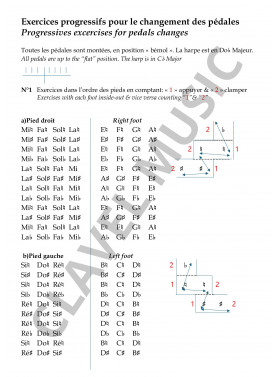Progressive Technical Exercises
Over her 45 years of teaching, Sophie Clavel has crafted these progressive, precise, and methodical exercises for concert harpists. First designed for her students in the United States, in Taiwan, and now in France, she has chosen to share her approach—ranging from efficient pedal coordination to visual reflexes for fingerings, along with targeted practice strategies that build a fluid and reliable technique.
Mastering the art of changing pedals at the right moment, in rhythm and with steady counting; knowing exactly how to work on arpeggios, ascending and descending scales, or challenging passages using broken rhythms and varied accents to free the fingers—such skills ensure an even, balanced tone and a refined harp performance that truly enhances both the musician and the instrument. And beyond that, this method helps players memorize their music even more quickly.
Whether written in syllables or letters, these exercises gradually awaken a genuine “foot memory,” developing an instinctive reflex for reading. Pedal changes are — or should always be — marked between the right-hand and left-hand staves. The harpist’s gaze encompasses a wide visual field: from the highest right-hand notes to the lowest basses of the left hand, including fingerings, accidentals, and dynamics. The pedal change should never become an added burden.
-
Progressives technical exercises for harp: pedals PDF
€5.60Written in syllables or letters, these exercises develop the reflex of “foot reading.” Pedal markings are (or should be) written between the right-hand and left-hand staves. Our reading field covers a considerable vertical space: from the right-hand line to the left-hand basses, including fingerings for each hand, accidentals, and the corresponding pedal indications. Fast reading, instant reflexes and immediate reaction — that is the secret to efficient practicing, sight-reading, ensuring solid and effective work from the very start.
5 pages



